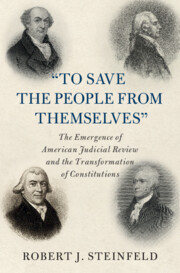 'To Save the People from Themselves'
'To Save the People from Themselves' from II - The Emergence of American Judicial Review, 1784–1787: Developing Judicial Review as a Check on Legislatures and on the People
Published online by Cambridge University Press: 17 September 2021
Like the two earlier cases, Rutgers v. Waddington grew directly out of the events of the Revolutionary war. After being driven out of Boston in the spring of 1776, the British army adapted its strategy in America, determining to invade and occupy New York City, preparing the groundwork for an attempt to drive a military wedge between the New England colonies, parts of New York and the remainder of the country. Following a series of American defeats in the late summer and early fall of 1776, the British Army took possession of New York City and its immediate surroundings, where it remained for the next seven years, only departing in November, 1783 after the Definitive Treaty of Peace had been signed. Great numbers of Patriots fled the British occupation, abandoning the properties they owned in the city.
To save this book to your Kindle, first ensure [email protected] is added to your Approved Personal Document E-mail List under your Personal Document Settings on the Manage Your Content and Devices page of your Amazon account. Then enter the ‘name’ part of your Kindle email address below. Find out more about saving to your Kindle.
Note you can select to save to either the @free.kindle.com or @kindle.com variations. ‘@free.kindle.com’ emails are free but can only be saved to your device when it is connected to wi-fi. ‘@kindle.com’ emails can be delivered even when you are not connected to wi-fi, but note that service fees apply.
Find out more about the Kindle Personal Document Service.
To save content items to your account, please confirm that you agree to abide by our usage policies. If this is the first time you use this feature, you will be asked to authorise Cambridge Core to connect with your account. Find out more about saving content to Dropbox.
To save content items to your account, please confirm that you agree to abide by our usage policies. If this is the first time you use this feature, you will be asked to authorise Cambridge Core to connect with your account. Find out more about saving content to Google Drive.